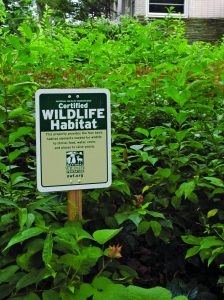Go Wild With Landscaping
“Look to the wild,” suggested Thomas Rainer, co-author of “Planting in a Post-Wild World.”” His advice is intended for anyone who influences a patch of land, whether a sprawling backyard in suburbia or a micro garden squeezed between row houses downtown. Self-described as “a landscape architect by profession and a gardener by obsession,” Rainer challenges homeowners and landscape designers to forgo rote installation of formal landscapes. Instead, he recommends an emerging style of design: a hybrid of the cultivated influenced by the wild.

This non-traditional planting by Adam Woodruff creates a loose tapestry of beauty using species of different sizes, metabolisms and structures. Photo from”Planting in a Post-Wild World”
“The future of planting design is based on what plants do in the wild,” Rainer said. “It’s also an answer to the problems of modern times, such as species invasion, urbanization and climate change.”
Margie Ruddick, author of “Wild By Design,” is another advocate of the wild gardening movement. The internationally renowned landscape designer notes that wild-inspired landscapes support sustainability and more.
“As we bring the wild back into everyday design, we create healthy landscapes that reconnect people with larger natural systems,” she said. “We also make beautiful places.”
Both designers explore wild-scapes—unspoiled meadows, fields and forests—seeking design inspiration and sustainability methods. Perhaps a few of their tips will prove helpful in your own gardening and landscape design.

International landscape designer Margie Ruddick forgoes formal design in her home’s front garden, opting instead for a blousy mingling of greens, flowers and herbs. Photo from “Wild By Design.”
Tip 1: Study comparable plant communities as they grow in the wild. “Consider a plant’s naturally occurring social interactions,” Rainer said. “In the wild, does it grow individually or in masses?” Plant likewise, and pair complementing plants as found in nature. Also, rather than over-fertilizing soil, replicate the natural soil and conditions of the plants to help ensure success. “Highly fertile soil and lots of mulch just let the weeds survive,” he said.
Tip 2: Plant in vertical layers. Rainer suggested that naturally growing plant communities have specific layers that savvy gardeners can mimic. Start with structural and framework plants, such as trees, shrubs and upright perennials. Next, select mid-height plants that offer seasonal drama through textures or flower colors displayed at various times of the year. For the lowest layer, skip hardwood mulch. Instead, plant “green” mulch that functions as a ground cover while visually holding together the plant community. Finish the bed with temporary plant fillers that cover bare spots until the permanent plants mature and provide visual interest.

Educational signage is one way to help unappreciative neighbors embrace wild-inspired landscapes. Photo by Margie Ruddick
Tip 3: Remember that wild and chaotic are not the same thing. “A wild landscape can be blousy and unbuttoned, but it shouldn’t be chaotic,” Ruddick cautioned. “There must be a visual legibility through managed growth…and that actually requires more skill.” Strategically placed structures, such as low walls, pathways or hedges, can provide aesthetic frameworks that help define freestyle mixed plantings.
Tip 4: Aim for designs that encourage interaction. “Don’t just put plants out as a showcase,” Ruddick recommended. “Create a living, breathing landscape that is approachable, one you can interact in.”
Tip 5: Be patient and flexible. When Ruddick moved into her Philadelphia neighborhood, she watched nature in action for years before significantly altering her home’s landscape design. “You have the license to wait and see what happens naturally,” she said. “Then you need to manage the process and growth very carefully.”
She notes that homeowners and designers must sometimes shift their expectations, as well.
“When you’re wild with design, you think you’re going in one direction and sometimes you go somewhere else,” she said. “It’s wondrous to embrace what wants to grow there.”
This article first appeared in the Richmond Times-Dispatch, December 2016.